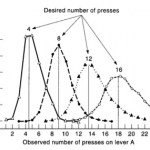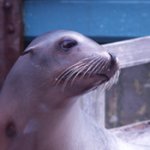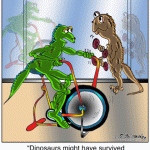
Here are my Research Blogging Editor's Selections for this week.
To start things off, be sure to check out the "What is Mental Illness? Mini-Carnival" that I hosted at The Thoughtful Animal, which included entries from BPS Research Digest, Neurocritic, Neurotic Physiology, Psycasm, and myself.
John Wayland at The History of Psychology tells the tale of the most famous baby in psychology: Little Albert.
Neurologists taking a stand against concussions? Brian Mossop at The Decision Tree blog discusses new guidelines from the American Academy of Neurologists regarding how soon athletes can…
From the new National Geographic Great Migrations mini-series.
Open comment thread: Did you watch it last night? What did you think?
Despite the fact that my research lies at the intersection between cognitive, comparative, and developmental psychology, I am also quite interested in the evolution of our understanding of psychopathology. The ultimate goal of the study of psychopathology is to ground such disorders in brain and body. But our understanding of some pathologies are simply not there yet (though some of our therapeutic interventions still prove effective even if we don't quite understand the etiology of a given disease or disorder). The main conflict in the field that characterizes the study of psychopathology is…
Welcome to the mental illness mini-carnival! Mental illness, or psychopathology, is a field riddled with controversy and it can be sometimes confusing to wade through all the uncertainty and conflicting data and opinions. In an effort to help make sense of some of it, your faithful psychology and neuroscience bloggers are here to help.
"Illness is like the street you've driven down your whole life. So familiar you've never bothered to look around. We've all experienced illness, either first-hand or via someone we know, but rarely do we stop to wonder what it really is." Christian Jarrett of…
"When men wish to construct or support a theory, how they torture facts into their service!"
Even in 1852, psychologists like Charles Mackay, who wrote those words in his book Extraordinary Popular Delusions and the Madness of Crowds, were well aware of the dangers of confirmation bias.
I was reminded of the pervasiveness of this cognitive bias last weekend during a visit to GlaxoSmithKline's vaccine distribution facility in Marietta, Pennsylvania. Confirmation bias is as dangerous in 2010 as it was in 1852.
I was invited by David Wescott to join a group of bloggers for an event at GSK's…
I don't often get too personal on this blog, but today is an important day. Fifteen years ago, Israeli Prime Minster Yitzchak Rabin was assassinated after speaking at a peace rally in Tel Aviv in Kikar Malchei Yisrael (now called Kikar Rabin).
I don't have very many flashbulb memories from my childhood, but one of my most vivid memories were of watching PM Rabin and Chairman Arafat sign the Oslo Accords on the South Lawn of the White House on September 13, 1993. I was in the third grade, and we were allowed into the teachers room (!) where there was a TV set up so we could watch the…
There is only one month left for submissions! Dig through your archives, through other people's archives and submit! I've already started to contact potential reviewers for this year's anthology. We're ready to roll!
Note: if you have recently moved your blog, please e-mail Bora the corrected URLs for your entries
The list is growing fast - almost FIVE HUNDRED posts have been submitted so far! Check the submissions to date and get inspired to submit something of your own - an essay, a poem, a cartoon or original art.
The Submission form is here so you can get started. Under the fold are…
Carnival of Evolution #29 is being hosted this month at Byte Size Biology. Click on the big green button for lots of evolutionary wonderfulness.
Here are my Research Blogging Editor's Selections for this week:
Another week of top-notch psychology and neuroscience blogging!
Should captive cephalopods be kept in "enriched" environments? Mike Lisieski of the Cephalove blog says yes: "Generally, providing enrichment for captive cephalopods seems worth it."
" Psychologists are starting to look at how expert dancers learn and remember dance steps and what gives them the advantage of expertise in their style." How do ballerinas make it look so easy? An interesting offering from the students of the Cognition and the Arts class.
"Either we…
In March 2000, Dr. Simon Chapman and colleagues from the University of Sydney published a paper in which they assessed the effectiveness of an educational intervention for the prevention of dog bites in children.
"Prevent-a-Bite" is an educational programme designed for primary school children. The programme aims to instill precautionary behaviour around dogs, assuming that this might reduce the incidence of attacks. A randomised controlled trial of the efficacy of the intervention was conducted in Australian children aged 7-8 years who were presented with an unsupervised opportunity to…
A nice video from our friends at BBC Earth:
...although I'm not sure why some of the critters in there qualify as scary. In any case, have a Happy (and Safe!) Halloween!
Meet Rio.
Rio is a California Sea Lion (Zalophus californianus). She was born in captivity at Marine World in Northern California, and due to insufficient maternal care from her biological mother, she was transferred to the Long Marine Laboratory at UC Santa Cruz when she was just a few days old. There, she was raised by a human surrogate mother, in the context of an imprinting study. She's got a pretty good life. She gets all the fish she could want, and has 3 other pinniped (seals, sea lions, otters) friends at the lab. There's Burnyce, a female Northern elephant seal, Sprouts, a male…
Here are my Research Blogging Editor's Selections for this week.
This was an awesome week for psychology and neuroscience blogging! I had a hard time picking just three or four, so here are six:
Korsakoff's Syndrome is a fascinating neuropsychiatric disorder marked by fantastic stories, told by patients, about things that have happened to them. Neuroskeptic discusses an interesting new paper on the evolving understanding of this rare disorder.
In a Halloween-inspired post, Brad Walters of "Cortical Hemming and Hawing" retells the legend of Bloody Mary and offers some thoughtful hypotheses as…
Have you ever been walking through the forest and thought to yourself, "Damn, its loud here...it's really, really hard to hear anything anybody else is saying"? Well, maybe that's what prompted Terry J. Ord and Judy A. Stamps, respectively from Harvard and UC Davis to investigate lizard exercise routines.
You ask: What do lizard calisthenics and communication have in common? Patience, grasshopper.
Dinosaurs also might have survived if they weren't eaten by giant snakes.
A noisy environment makes it particularly challenging for animals to detect communication signals from far away. In this…
Last night, I was a guest of the National Geographic Channel at the historic Saban Theater in Beverly Hills for the United States premiere of Great Migrations, which airs internationally on Sunday, November 7.
Great Migrations is a 7-part TV "event," paired with an issue of National Geographic magazine, a set of kids' books, iPhone apps, and so forth. The mini-series, narrated by Alec Baldwin, focuses on the movements of animals across the earth in an effort to find food, to mate, and to survive. The first hour, which was screened for us, featured the migration of the monarch butterfly from…
Check out this awesome David Attenborough video:
So far the readers of this fair blog have managed to fully fund two Donors Choose science education requests. We can do better. Do you like the stuff that you read here? Do you like David Attenborough? Consider donating to this project.
Mr. T teaches at a "high poverty" high school in Los Angeles. He writes:
I teach Biology and freshman science in an inner city/urban public school where over 50% of students qualify for free and reduced-price lunches. Daily life is often a challenge for many students, so textbook learning due to lack of…
Here are my Research Blogging Editor's Selections for this week:
"Amazingly, babies as small as 12 months old show some understanding of the difference between the deliberate and goal-directed "agents" that can cause order, such as a person, and those randomly acting inanimate objects that cannot, such as a bouncing ball." Daniel Daza of the Ego Sum Daza blog explores an interesting new PNAS paper. Babies, Balls, and Creationists.
Sandy Gautam of The Mouse Trap wonders: is altruism the result of sexual selection?
Finally, welcome John Wayland of the new History of Psychology blog to the…
In 1975, Edward Tronick and colleagues first presented the "still face experiment" to colleagues at the biennial meeting of the Society for Research in Child Development. He described a phenomenon in which an infant, after three minutes of "interaction" with a non-responsive expressionless mother, "rapidly sobers and grows wary. He makes repeated attempts to get the interaction into its usual reciprocal pattern. When these attempts fail, the infant withdraws [and] orients his face and body away from his mother with a withdrawn, hopeless facial expression." It remains one of the most…
Non-human primate, that is.
Ape actor Peter Elliott shares his knowledge of chimpanzee and gorilla vocabulary and facial expressions.
via IMDb:
Peter Elliott is the film industry's primary primate. He both as a performer, in films like Missing Link and The Island of Doctor Moreau, and as a choreographer of other performers, as in Gorillas in the Mist and Congo. He also teaches animal study at London's Central School of Speech and Drama.
Does Fido see the cup as half full? Is your dog pessimistic? Last time we saw headlines like these they were about a certain barnyard animal. Remember "Pampered pigs 'feel optimistic'"? I didn't like it then, and I don't like it now.
Roughly half of the population of dogs in the UK are likely to - at some point in their lives - exhibit "undesirable separation-related behavior (SRB)." These are things that sometimes happen when left alone, like barking, chewing up or otherwise destroying objects, and urinating (or worse!) inside the house. While some owners view these behaviors as fine and…











